I am Not a Virus
I am Not a Virus even if the TV says so
I am Not a Bludger even though the papers tell me so
I’m not surplus even if the economy thinks so
I’m not asking for it even when the frat boys say so
No human being is Illegal even if the pollies say so
No human being is Trash even when the minister says so
No species is expendable even if developers say so
No water supply is unnecessary even when miners think so
No one is disposable even if we live in nursing homes
No one is undeserving even if I’m a Westie
I’m not a burden even if I’m disabled
I’m not a sinner even if your imaginary friend thinks so
Cos your dogma is not my dilemma
Once Were Neighbours
Across the fence
They traded insults
He called them ‘White trash’
They called him ‘Brahmin trash!’
He threw chilli
They threw garbage
He defaced their car
They sent threats
Neighbours took sides
Their gods collide
Quoting Bibles
Chanting Mantras
Papers fan the flames
A knife was pulled
People stabbed
Both sides protest
Righteous rage expressed
Where would it end?
Holy War, Crusades
Bloody Sunday?
Then night horror…
Women butchered,
Blood trains in Lahore
So eye for eye
With gods on side
Wrought Hell on Earth
Communal cleansing
Mass murder
Millions homeless
Madness at midnight
A subcontinent
torn asunder
The End of Time
a dematerializing mass
a physical force
a knowing, wanton, seamless mystery
unfolding with ever-increasing power
a power that destroys all organic
matter within its reach
and time stands still
time explodes, rockets, wavers
time is neutral
time is unsympathetic
life cycles dissolve before their time has come
and a life cycle begins when time calls it
what time is left to start anew?
Will a new day begin?
Tony
Lost in a grey skid they call life.
Going nowhere, killing time.
Waiting to die.
Too young to grow old.
Counting time by the needles
The point eases in and withdraws
Tension ebbs away
In the stream that now flows
Around the brain in soothing waves.
The only freedom left is the freedom to forget.
Reassuring, floating, plummeting
OBLIVION sends its own merciful deliverance
To those condemned
The Squat
Sitting in a room on a wooden floor
no furniture, space encloses me.
Gazing at the gentle fire that
sometimes erupts in violent spasms
Then silence,
Alone at last
to contemplate my own being
The Stairwell
An echo lingers,
approaches,
stops,
stillness
Footsteps getting closer,
hesitation
a dark figure appearing,
darker still
as shadows circle
for a moment watching,
then disappears again.
Newcastle
No place to stay
feel like I'm a stray.
No jobs around
nothing to be found.
Something in the air,
coal dust everywhere
Kids got asthma
folks all choked up.
Companies winning coal
Put our dreams on hold
Tear up our valley
Roll whoever they want
Baby don't suffer,
get another puffer
Shonks paid to supervise
And control lives
All the jobs are gone.
Say its our fault.
Losers then get old.
Question what you’re told.
Hell with charity,
need equality.
Its a class war
what are you waiting for?
CRAPITALISM
Hi, I’m a welfare recipient with an attitude problem. Not that I’m complaining cos we’re living in the best country money can buy and going fracking cheap too! And such a clever country with public transport experts who wanna ban welfare recipients from travelling at peak hour.* What will they think of next - make us wear a black star or tattoo perhaps? Achtung, eine velfare recipient. Das ist Verboten! Like they say: “American Express – don’t leave home without it” but if you’re on welfare then just don’t leave home!
In fact there’s only one thing worse than being a welfare recipient and that’s being a disabled welfare recipient. But whatever doesn’t kill you makes you stronger like my job capacity assessment. Hey guys, don’t diss my disability. You know being on welfare makes us aspirational voters – we take an aspro every time we get called into Centrelink. Gees it’s been at least 2 weeks since the last compulsory client review – must be time we checked up on them again! At this rate we’ll have one half of Australia being paid to watch the other half – ASIO eat your heart out. And deciding which major party to give our preferences to is a real pain. Do we vote for the one that’s anti-welfare or the one that’s uber anti-welfare? Next election I’m telling them: “not tonite dear I’ve got a headache”.
Besides anyone on less than two hundred grand a year’s got character flaws so suck that. Well Gina Reinhardt must be Mother Theresa or maybe Australia’s first saint – our lady of dollars, patron saint of crapitalism. Religion’s a bit like a shit sandwich – the more bread you got the less shit you eat.
The Greens have got the right idea – just recycle everything. Ya recycle holy water by boiling the hell out of it and reuse toilet paper by beating the crap out of it. So why not losers too? Yeah fuck all those broke useless cripples and redundant workers. All they need is tough love to cure their character flaws. Then when they get depressed and suicidal and can’t afford to eat we’ll ask for more psychiatrists. So why not get welfare recipients to line up and jump off a big, tall tower? We’ll have the shrinks standing by telling them it’s all mind over matter – Australia doesn’t mind and you don’t matter. But that could be messy, maybe we need a ‘Pacific solution’ – it works so well for refugees why not jobseekers? So next time some retrenched worker turns up at Centrelink we’ll stick a sign on the door saying: “Piss off, we’re full” and send them to Christmas Island for processing. If they get shipwrecked and tossed into the sea, we’ll throw them a Hillsong Church sermon: “A hand up not a handout! Jesus loves a billionaire, greediness is next to godliness”.
Guess I’m an expert now cos I received help from the government’s welfare-to-work reforms. I phoned their help line to tell them their ‘help’ wasn’t very helpful and a voice on the other end says: “ We’ll decide what’s good for you not you!”. After that kind of help I get a nervous breakdown and referred to the Commonwealth Rehabilitation Service. They send me a glossy brochure with all these smiling faces saying how much they’re gonna ‘help’ me. So I turn up at this CRS panel with a dozen people sitting around a table the size of a football field.
“Look” I say “I’ve got depression, a dodgy back and wrist and I’m looking after a kid and a mother with dementia.” I ask for physiotherapy – but they’ve got no money for that.
“What about helping me contact employers and typing job applications?” Not bloody likely.
“So what can you do for me?”
“We will supervise your efforts to find employment.”
Well at least its keeping them off the streets – the CRS I mean, because I’d hate to meet them in a dark alley. They mugged me from behind an office desk – imagine what they could do in a balaclava!
Who needs the CRS anyway when we’ve got the Starvation Army’s Employment Pus. They breach jobseekers for being just five minutes late to their lousy seminars on how to write a letter to an employer. Never mind the futility of learning to beg for jobs that don’t exist. Or that we've done the same job training ten times over. NO EXCUSES!
“Your bus was running late? That’ll be 6 months of bread and water for you!” Thank god for the Salvos? How about some truth in advertising like:
“Help us to help Australia beat up the underemployed” or
“This winter, give generously to authority, make charity history.”
Street beggar signs should say: “Forget spare change, we need real change!”
* http://www.busnews.com.au/news/industry/1107/restrict-sydneys-concession-users-says-academic
Berlin Dayz
The euphoria was long gone when I visited Berlin two years after the wall came down. I remember having breakfast with a Dutch traveller from my hostel then we headed off to explore the old East Berlin. We walked a mile or so crossing into ‘no man’s land’ then sat down on a bench to rest.
For some time a strange melancholy descended until my companion broke the spell:
“Communism could never last but it wasn’t all bad was it? And they did some good things didn’t they?” she mused.
It sounded somehow reasonable so I agreed without quite knowing why. Then she prodded further:
“So what were some of the good things the Communists did in Australia?”
I told her she should ask the experts but she wasn’t interested in experts only what ‘ordinary’ Australians thought.
After an embarrassed silence I had a Eureka moment and explained that Australian Communists were among the first to support Aboriginal rights.
“Oh yes of course! But wasn’t there anything ELSE?” she prompted.
Feeling as if the glare of every searchlight on Death Strip would expose my ignorance I feigned the excuse of not having drunk enough coffee.
We wandered off and soon fell about laughing after stumbling across a larger than life public statue of Lenin, Marx and Engels – something totally taboo in our countries. She dared me to clamber up the pedestal and pose with them while she took a photo. So I hammed it up with one arm around Lenin and the other punching the air. A bemused German stopped to look and commented in rather crisp English:
“Ah, I see we have the last Communist.”
Finally I was an expert.












